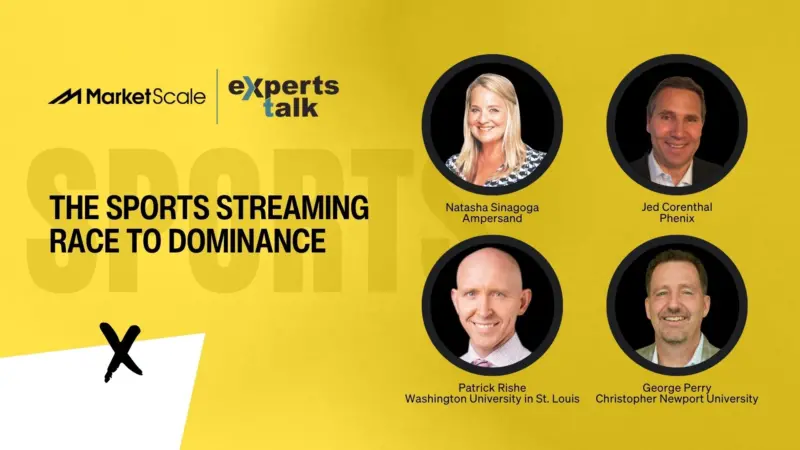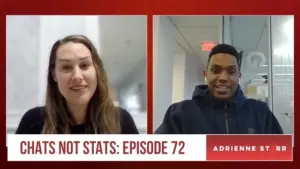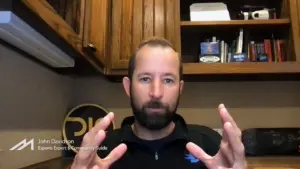Mercer University Assistant Sports Marketing Professor Lane Wakefield, Ph.D. Explains the Five Goals of Social Media Marketing
Social media marketing has come a long way from simple Facebook posts and static content. Nowadays, marketers are exploring two distinct forms of social communication: archived and ephemeral communication, and how to vary their marketing message accordingly.
What is ephemeral content, you ask? Today on the Digital Marketing Professor Series brought to you by Marketscale, we sat down with Lane Wakefield, Ph.D, Assistant Professor of Sports Marketing & Analytics at Mercer University, to define ephemeral content and explore the five distinct goals of this form of social media marketing.
“In ephemeral content, brands and marketers can be more relational and think about how to make a friend and not how to look good for the other thousands of people that are going to read this,” Wakefield said.
These five goals — basically the social post’s purpose — help us understand and focus our marketing efforts toward creating content that feels germane to the social platform; that makes for better digital content all around.
HIGHLIGHTS FROM THE EPISODE
Lane Wakefield: So the way I like to think about it is the first form of communication, you know, cavemen way back when, you know, is talking. They figured how to talk and so that’s ephemeral communication. So it goes away, deletes naturally, that’s the earliest kind of form of communication. But then archived communication came along, that’s your cave drawings but then, you know, eventually it got to writing and they’re pretty impressed. And more recently you’ve got the VHS tapes and video and more things are becoming archived.
So ephemeral and an archived is the other end of that. So that’s all offline. So up until 1996 or 2000, whatever you want to call the beginning stages of the internet or even earlier, offline, archived and ephemeral communication came first and then online. So the online archives, communication is what we all know about. Up until the last few years everything you put online, whether it’d be a blog or a Facebook message or a review on Yelp, it’s permanent, more or less, right? It’s archived. And now this ephemeral communication is not exactly like, you know, offline communication, but it behaves in some similar ways. So knowing this at the beginning that this is kind of it’s not a fad, it’s not kind of a new thing that the kids are enjoying on Snapchat and it’s going to go away, it’s part of I guess the evolution of communication.
Shelby Skrhak: So you’re juxtaposing ephemeral communication to archived communication and archived has been those traditional marketing messages that we’ve seen especially within social media. So those are Facebook posts and Twitter and Instagram photos and those sorts of things.
LW: That’s right.
SS: But with the ephemeral, what is the goal? I mean is it to make a sale? Is it brand awareness? What is the ultimate goal for that type of communication?
LW: That’s a great question. Caleb and I have settled on five goals that we think people have when they’re communication based on research. Jonah Berger has done some great work outlining what word of mouth and communication is about, what people are talking about and why. Ephemeral might be better suited to reach some goals versus others. For example, you know, one goal for people is to look good no matter where you are, how you’re communicating. Some people want to look better or manage their impression when they’re talking. So it’s Facebook Status or your Instagram post, I mean you put the best of there, right? I mean, can you remember the last thing that you posted, Shelby?
SS: It probably wasn’t my lowest darkest day, it was of course to highlight.
LW: Right. At the very least, it’s something cool that you ate at a restaurant or a picture of maybe an event you were at. But on the other end, people are going to go even further and adding their own doodles and artwork and just showing their creativity, whatever their goal within that self-enhancement or impression management goal it might be. They’re taking the extra effort to show who they are and then I’m better than maybe, might be in real life. That’s one goal that’s important in archived social media if we want to talk about that context but less important in ephemeral.
You know, online ephemeral communication, those goals aren’t there anymore because that message isn’t around and people aren’t going to share. I don’t have to worry you retweeting it or forwarding it to somebody else. So that takes a little bit of the pressure off and makes the communication a little easier to have and easier being not to worry about some of the future as much, even say in the present.
For brands and for marketers, you know, they can be more relational. They can think about how to really make a friend and not how to look good for the other thousands of people that are going to read this.
SS: What are some of the other goals of communication?
LW: Sure. Another one is social bonding. People will talk to make friends or make new acquaintances or make the friendships that we already have even stronger. Another would be utilitarian or acquiring information. So I might talk to find out what’s the next deal at Target. Is there something that I can buy on sale maybe at Walmart or wherever it is that you shop? Let me find out something I can take and use right away, some information that’s functional. And the flipside of that, as you might guess, is hedonic or kind of fun goals. So there’s some fun things that we can find out through communicating whether it’s sharing a funny meme or a YouTube video or whatever that might be. Those are different goals people might have. So how do those stack up with ephemeral versus archive, online versus offline? One of those for example on the social bonding is one that we’ve identified are more likely to be used for ephemeral communications over online archived communications.
Well, first of all, the audience is a little smaller and it’s more specific. So when you’re getting into Instagram Stories, you know, limited to those people that you’ve given access to be your friend on Instagram and also it’s probably a few less people that are going to see it within 24 hours before it goes away. So you know there’s a closer group to you which helps. So using online ephemeral communication is a better way to build relationships and friendships because those channels help people filter out people they don’t want to talk to which is kind of nice. People have to have access that we explicitly invited or at least accepted from other people. So it’s easier to keep the right people in the group. So it’s a way that you know, “This is a communication that I’m going to use for my friends.” And one interesting thing, Shelby, is that people are more likely to perceive their compliments that they receive as genuine. That means a little bit more than if they just post it on Instagram, a regular photo or on Twitter or a Facebook status. Any idea why?
SS: I guess it’s just that inner circle feeling.
LW: Right. So it’s just for these people, but it’s more genuine because when people are posting on archived social media for example like Twitter, then there’s an audience there for them.
SS: The third goal of communication you said was utilitarian basically information sharing, right?
LW: Yeah, trying to figure out something that might be functional or helpful for me in communicating. And so the reason why online ephemeral communications might be the less effective for that is because the information is not permanent and so that makes it harder for me to find it maybe later on when I need it, whether I’d be a coupon code or attribute of a particular product. So you can’t go back and find it. But if it’s on an email or even a Facebook post or any archived setting, you can go look that up and find information when you need it. Also ephemeral communication are less efficient for sharing information because the audience tends to be smaller and the channel is more synchronous compared to online archived communications.
SS: So that fourth goal of communication, hedonic.
LW: Yeah, hedonic. I mean that’s a lot of what these communications hopefully are, are fun. I want to talk about stuff that’s fun. It makes me happier. This is an interesting goal for people in online ephemeral communications because we think these communications are going to be more valuable to people that want to have fun. The first reason is they’re more likely to be visual, the content is more visual than verbal. The second, they typically include tools for making content more fun. And the third one, communication is more likely to occur between people who are, you know, close socially. And the fourth, there’s less pressure from other communication goals. So the ones we’ve mentioned so far, those are the less important to have a little bit more fun.
SS: Right. That makes sense especially within the sports and entertainment industry. That’s the chance to pull back the curtain and show some goofiness or show levity within, you know, either a personality, a brand, or a team. That’s the fun part of it because if you’re a fan, you want to see that stuff that feels very real and genuine.
LW: Right. Yeah. And sports is a great example and those teams are doing an excellent job of giving you content that is fun, that is interesting, and it doesn’t cost them anymore, but it provides a lot of value to a fan who cares a lot about their team and there are people that spend inordinate amounts of money, time, they reorganize their whole schedule around whatever that next ballgame might be. So their passion is what we talked about. Fun, how light-hearted content is right up their alley and even people that outside of sports. I mean, that’s what people want and online ephemeral communication that’s latent streaming, that’s something they can check any time on the go, it’s not a big deal if I miss it.
So one thing Shelby with that, you know, in sports and out of sports is that marketers need to know you can send far more content than in any other form of communication, right? If you send an email, there’s a limit. If you’re putting advertisements in any other location, there’s a chance for overkill. Online ephemeral communication, it doesn’t stack up. There’s not a bunch of emails to delete or block or anything. It’s just 24 hours and that could be 50 Instagram stories if you want there to be and it’s going to bother me. I’m not going to unfollow you because you did that because I can easily skip it and I might not even notice you send them to begin with.
For the latest news, videos, and podcasts in the Sports & Entertainment Industry, be sure to subscribe to our industry publication.
Follow us on social media for the latest updates in B2B!
Twitter – @SportsEntMKSL
Facebook – facebook.com/marketscale
LinkedIn – linkedin.com/company/marketscale








